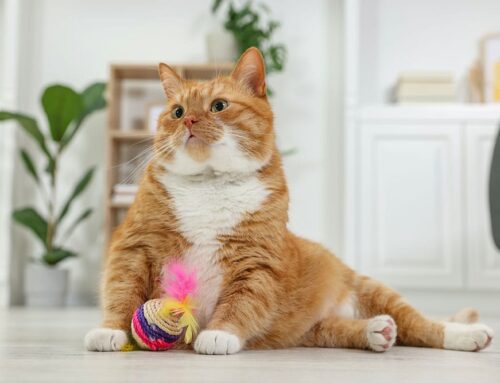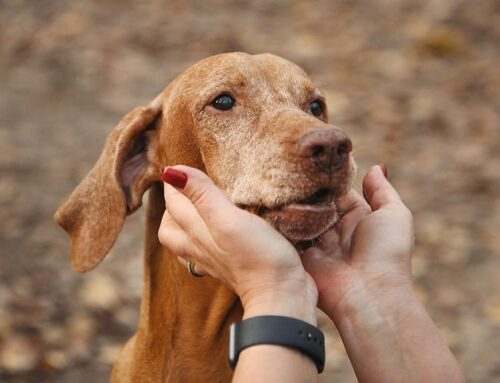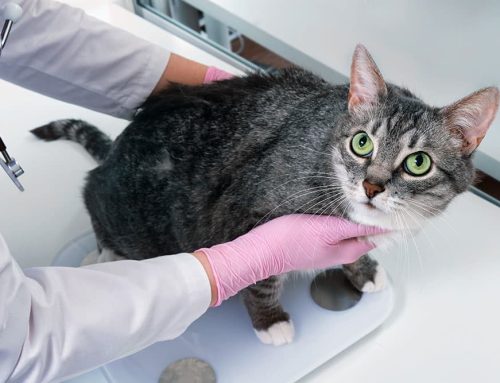Pet obesity is a serious problem, affecting more than 50% of U.S. pets. If your pet is overweight, their health is at risk. Our Mobile Cat & Dog Vet team sees many overweight pets every day, and we provide answers to frequently asked questions (FAQs) about pet obesity and weight management.
Question: Why do pets gain excess weight?
Answer: The most common reason that pets gain excess weight is overfeeding. Many pet owners are overindulgent, feeding their cat or dog table scraps and treats, which causes weight gain. Other overfeeding issues include:
- Uncooperative family members — Feeding your pet a healthy diet is possible only if all household members follow the rules. In addition, if you have small children, your pet may take advantage of their unattended snacks.
- Genetics — Some dog breeds have genetic tendencies toward obesity. These include golden retrievers, cocker spaniels, dachshunds, beagles, Basset hounds, and Labrador retrievers.
- Medical conditions — Certain medical conditions, such as hypothyroidism and Cushing’s disease, can lead to weight gain.
Q: How does obesity affect pets?
A: You may think your pet’s fat rolls are cute. However, if your pet is overweight, they can experience serious health consequences, including:
- Decrease longevity — Studies have demonstrated that healthy weight pets live about 2.5 years longer than overweight pets.
- Decreased mobility — Carrying excess weight makes moving difficult, and overweight pets do not usually enjoy active recreation. In addition, overweight pets are at an increased risk for arthritis, further limiting their mobility.
- Diabetes — Obese cats have a 50% decrease in insulin sensitivity, increasing their diabetes risk.
- Cancer — Being overweight has been linked to several cancers in people, and evidence suggests that the same is true for pets.
- Respiratory complications — Excess chest cavity fat prevents the lungs from fully inflating, leading to respiratory complications. Overweight pets are also at an increased risk for tracheal collapse.
- High blood pressure — Overweight pets often have high blood pressure, which can lead to issues such as kidney disease, vascular problems, and retinal detachment.
- Hepatic lipidosis — If an illness or stress causes an overweight pet to stop eating suddenly, fat can infiltrate the liver, resulting in a potentially life-threatening condition.
Q: How do I know if my pet is overweight?
A: Most pets you see on television and social media are overweight, so you may have difficulty determining whether your own pet is at a healthy weight. The best way to assess your pet’s weight status is to evaluate their body condition score (BCS). This is a simple, subjective tool that uses a nine-point system to score your pet based on observing them from above and from the side and palpating their ribs and hip bones. Five is considered an ideal score.
Q: How do I maintain my pet at a healthy weight?
A: Your pet’s health is at risk if they carry excess pounds, but you may feel overwhelmed at the thought of trying to help them lose weight. To help your pet reach a healthy weight and maintain that level, follow these tips:
- Scheduling regular wellness examinations — Schedule regular wellness examinations, so your veterinarian can assess your pet’s weight status, track changes, and suggest an appropriate diet and exercise program.
- Determining your pet’s caloric needs — Consider your pet’s breed, age, activity level, and spay or neuter status to determine their daily caloric needs. Online tools help make these calculations easier.
- Feeding appropriately portioned meals — Leaving food out for your pet encourages grazing and overeating. Feed your pet appropriately portioned meals to ensure they don’t overindulge.
- Measuring your pet’s food — Use a measuring cup or a gram scale to measure your pet’s food amount accurately. For example, if your pet should receive ¼ cup of food, ensure you level the top, because a few extra pieces can add a lot of extra calories, especially to your cat’s or toy-breed dog’s daily caloric intake.
- Limiting treats — Treats should account for no more than 10% of your pet’s daily caloric intake.
- Choosing healthy treats — Provide healthy treats, such as baby carrots, green beans, and sliced cucumber, and avoid high-fat options.
- Exercising your pet — Exercise your pet daily to help them stay fit and healthy. To keep your pet moving, consider these activity options:
- Walking — Take your pet for a brisk walk around the neighborhood.
- Fetch — Play a vigorous game of fetch with your pet.
- Swimming — If your pet loves the water, swimming is a great low-impact option.
- Chase — Use a wand-style toy or laser pointer to encourage your cat to run and jump.
- Competitive sports — If you have an active, high-energy dog, consider enrolling them in a competitive sport such as disc dog, agility, or flyball.
- Weighing your pet — Weigh your pet regularly so you can ensure they remain at a healthy weight.
Q: How can I help my overweight pet reach an ideal weight?

A: Never put your pet on a diet without consulting a veterinarian. A sudden calorie restriction can lead to serious health problems such as malnutrition and hepatic lipidosis. If your pet has a few excess pounds to lose, contact your veterinarian, so they can devise a safe weight loss program, which may involve a prescription weight reduction diet and a regimented exercise program.
If obesity is affecting your senior pet’s quality of life, contact our Mobile Cat & Dog Vet team so we can provide hospice care or other palliative support.








Leave A Comment